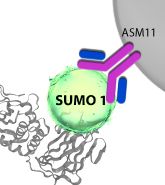Ubiquitin Antibody Mouse Monoclonal
Anti-ubiquitin antibody is a pan-ubiquitin, mouse monoclonal antibody that is part of the Signal-Seeker™ product line. The antibody was raised against full length bovine ubiquitin. The antibody has been shown to recognize poly-ubiquitin, mono-ubiquitin, and free ubiquitin (Fig 1). Ubiquitin is a highly conserved protein and AUB01 is predicted to recognize ubiquitin from a wide range of species (5). AUB01 is purified by Protein G affinity chromatography and is supplied as a lyophilized white powder.
Validated Applications
Western Blot using Ubiquitin Antibody
Anti-Ubiquitin Antibody (Cat. # AUB01) was used at a 1:500 dilution. Bovine thymus ubiquitin was run as follows; Lane 1-50 ng, Lane 2-25 ng. Lane 3– 12.5 ng, Lane 4-6.25 ng, Lane 5-3.12 ng. Lanes 6 & 7 represent 20 µg of Swiss 3T3 cell lysate from cells treated for 5h with 10 µM MG132 (Lane 6) or untreated cells (Lane 7). Arrow indicates free ubiquitin band (8 kD), higher molecular weight bands are ubiquitinated proteins. To see the full Western blot protocol, see the product datasheet.

HeLa cells were stained and visualized by fluorescence microscopy as described in the IF method below. Ubiquitin targeted cytoplasmic and nuclear proteins and free ubiquitin were stained using AUB01 at 1:500 dilution. To see the full Immunofluorescence protocol, see the product datasheet.

Ubiquitin Background
Ubiquitin (Ub) and ubiquitin-like proteins (Ubls, e.g. SUMO, Nedd) are a group of approximately 15 proteins that have a molecular weight of around 8 kD. During the ubiquitination process, these are conjugated via activating (E1), conjugating (E2) and ligating (E3) enzymes to lysines of a target protein (1). Mammalian cells express over 600 potential ubiquitin ligases which exceeds that of the kinase superfamily of PTM proteins (2).
One function of ubiquitination is to target proteins for proteosomal degradation. This role can range from a general housekeeping function that clears miss folded proteins from a cell to involvement in tightly regulated spatio-temporal cell signaling events (1). An emerging function of ubiquitination is its ability to activate proteins via the creation of unique protein:protein interactions (3). In common with many other PTMs, ubiquitination is reversible. Ubiquitin-specific proteases (USPs or DUBs) remove ubiquitins from target proteins (4). The reversible nature of ubiquitination further enhances the potential of this PTM to dynamically regulate protein function.
References
1) Grabbe, C. et al. 2011. The spatial and temporal organization of ubiquitin networks. Nat. Rev. Mol. Cell. Biol. 12:295-307.
2) Deshaies R.J. & Joazeiro, C.A. 2009. RING domain E3 ligases. Ann. Rev. Biochem. 78: 399-434.
3) Lomeli, H. & Vazquez. 2011. Emerging roles of the SUMO pathway. Cell Mol. Life Sci. 68:4045-4064.
4) Faesen, A.C. et al. 2012. The role of UBL domains in ubiquitin specific proteases. Biochem. Soc. Trans. 40:539-545.
5) Zuin, A. et al. 2014. Ubiquitin signaling: Extreme conservation as a source of diversity. Cells 3:690-701.
For more information contact: signalseeker@cytoskeleton.com
Associated Products:
Signal-Seeker™ Ubiquitination Detection Kit (Cat. # BK161)
Signal-Seeker™ Ubiquitin Affinity Beads (Cat.# UBA01B-beads)
Signal-Seeker™: BlastR™ Rapid Lysate Prep Kit (Cat. # BLR01)
For product Datasheets and MSDSs please click on the PDF links below.
Sample Size Datasheet (Cat. AUB01-S): ![]()
Bulk Size Datasheet (Cat. AUB01-XL): ![]()
Certificate of Analysis: Lot 001
For the most recent publications citing this and other Signal-Seeker™ products, see our Signal-Seeker™ Validation Data Page click here
Visit our Signal-Seeker™ Tech Tips and FAQs page for technical tips and frequently asked questions regarding this and other Signal-Seeker™ products click here
If you have any questions concerning this product, please contact our Technical Service department at tservice@cytoskeleton.com










